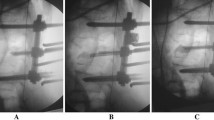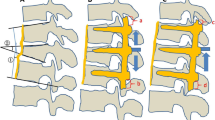Abstract
From October 2005 to September 2006, 20 patients with an acute thoracolumbar burst fracture underwent posterior instrumentation with transpedicular intracorporeal calcium sulphate grafting. The mean age of the patients at surgery was 41.8 years; 14 were men and six were women. The mean follow-up period was 28.5 months. Pre-operative computed tomography showed that the mean canal compromise was 53.5%. The Cobb angle was improved from 21.70 to 2.40°, and the final loss of correction was 4.60°. The anterior body height was corrected from 50.3% to 86.6%, and the average loss of anterior body height was 7.7% at final follow-up. All six patients with partial neurological deficit initially had improvement. According to the Denis criteria, the average pain score was 1.8, and the final mean work score was 2.5. Only one case had implant failure. Analysis of the results indicated that this technique can restore and maintain sagittal alignment and anterior body height, providing satisfactory short-term clinical results.
Résumé
D’octobre 2005 à septembre 2006, 20 patients ayant présenté une fracture thoraco lombaire ont bénéficié d’une instrumentation postérieure avec greffe transpédiculaire intercorporéale. Les patients étaient âgés de 41,8 ans au moment de l’intervention, 14 étaient de sexe masculin et 6 de sexe féminin. Le suivi moyen a été de 28,5 mois. L’angle de Cobb s’est amélioré de 20,80° à 2,40° et la perte de correction n’a été, au suivi final, que de 4,60°. La hauteur du mur vertébral antérieur s’est corrigé de 50,3% à 86,6%, la perte de hauteur n’a été de que 7,7% au dernier suivi. Les six patients ayant présenté un déficit neurologique partiel initial ont été améliorés. Selon les critères de Denis, la valeur moyenne du score était de 1,8 et le score travail de 2,5 au suivi final. Un seul cas présentait un débricolage des implants. L’analyse de ces résultats permet de penser que cette technique peut restaurer un bon alignement sagittal et la hauteur des corps vertébraux avec des résultats satisfaisants à court terme.


Similar content being viewed by others
References
Alanay A, Acaroglu E, Yazici M, Oznur A, Surat A (2001) Short-segment pedicle instrumentation of thoracolumbar burst fractures: does transpedicular intracorporeal grafting prevent early failure? Spine 26:213–217
An HS, Vaccaro A, Cotler JM, Lin S (1991) Low lumbar burst fractures. Comparison among body cast, Harrington rod, Luque rod, and Steffee plate. Spine 16(8 Suppl):S440–S444
Arrington ED, Smith WJ, Chambers HG, Bucknell AL, Davino NA (1996) Complications of iliac crest bone graft harvesting. Clin Orthop 329:300–309
Benson DR, Burkus JK, Montesano PX, Sutherland TB, McLain RF (1992) Unstable thoracolumbar and lumbar burst fractures treated with the AO fixateur interne. J Spinal Disord 5:335–343
Butt MF, Farooq M, Mir B, Dhar AS, Hussain A, Mumtaz M (2007) Management of unstable thoracolumbar spinal injuries by posterior short segment spinal fixation. Int Orthop 31:259–264
Chen WJ, Niu CC, Chen LH, Chen JY, Shih CH, Chu LY (1995) Back pain after thoracolumbar fracture treated with long instrumentation and short fusion. J Spinal Disord 8:474–478
Chen WJ, Tsai TT, Chen LH, Niu CC, Lai PL, Fu TS, McCarthy K (2005) The fusion rate of calcium sulfate with local autograft bone compared with autologous iliac bone graft for instrumented short-segment spinal fusion. Spine 30(20):2293–2297
Daniaux H, Seykora P, Genelin A, Lang T, Kathrein A (1991) Application of posterior plating and modifications in thoracolumbar spine injuries. Indication, techniques, and results. Spine 16(3 Suppl):S125–S133
Dekutoski MB, Conlan ES, Salciccioli GG (1993) Spinal mobility and deformity after Harrington rod stabilization and limited arthrodesis of thoracolumbar fractures. J Bone Joint Surg Am 75:168–176
Denis F, Armstrong GW, Searls K, Matta L (1984) Acute thoracolumbar burst fractures in the absence of neurologic deficit. A comparison between operative and nonoperative treatment. Clin Orthop 189:142–149
Gertzbein SD, Court-Brown CM, Marks P, Martin C, Fazl M, Schwartz M, Jacobs RR (1988) The neurological outcome following surgery for spinal fractures. Spine 13:641–644
Goulet JA, Senunas LE, DeSilva GL, Greenfield ML (1997) Autogenous iliac crest bone graft. Complications and functional assessment. Clin Orthop 339:76–81
Kaneda K, Taneichi H, Abumi K, Hashimoto T, Satoh S, Fujiya M (1997) Anterior decompression and stabilization with the Kaneda device for thoracolumbar burst fractures associated with neurological deficits. J Bone Joint Surg Am 79:69–83
Kelly CM, Wilkins RM (2004) Treatment of benign bone lesions with an injectable calcium sulfate-based bone graft substitute. Orthopedics 27(1 Suppl):s131–s135
Knop C, Fabian HF, Bastian L, Blauth M (2001) Late results of thoracolumbar fractures after posterior instrumentation and transpedicular bone grafting. Spine 26:88–99
Kostuik JP (1988) Anterior fixation for burst fractures of the thoracic and lumbar spine with or without neurological involvement. Spine 13:286–293
Limb D, Shaw DL, Dickson RA (1995) Neurological injury in thoracolumbar burst fractures. J Bone Joint Surg Br 77:774–777
Mirzayan R, Panossian V, Avedian R, Forrester DM, Menendez LR (2001) The use of calcium sulfate in the treatment of benign bone lesions. A preliminary report. J Bone Joint Surg Am 83:355–358
Müller U, Berlemann U, Sledge J, Schwarzenbach O (1999) Treatment of thoracolumbar burst fractures without neurologic deficit by indirect reduction and posterior instrumentation: bisegmental stabilization with monosegmental fusion. Eur Spine J 8:284–289
Mumford J, Weinstein JN, Spratt KF, Goel VK (1993) Thoracolumbar burst fractures. The clinical efficacy and outcome of nonoperative management. Spine 18:955–970
Oner FC, van der Rijt RR, Ramos LM, Dhert WJ, Verbout AJ (1998) Changes in the disc space after fractures of the thoracolumbar spine. J Bone Joint Surg Br 80:833–839
Parikh SN (2002) Bone graft substitutes in modern orthopedics. Orthopedics 25:1301–1309
Perry A, Mahar A, Massie J, Arrieta N, Garfin S, Kim C (2005) Biomechanical evaluation of kyphoplasty with calcium sulfate cement in a cadaveric osteoporotic vertebral compression fracture model. Spine J 5:489–493
Thomas KC, Bailey CS, Dvorak MF, Kwon B, Fisher C (2006) Comparison of operative and nonoperative treatment for thoracolumbar burst fractures in patients without neurological deficit: a systematic review. J Neurosurg Spine 4:351–358
Urban RM, Turner TM, Hall DJ, Infanger SI, Cheema N, Lim TH, Richelsoph K (2004) An injectable calcium sulfate-based bone graft putty using hydroxypropylmethylcellulose as the plasticizer. Orthopedics 27(1 Suppl):s155–s159
Author information
Authors and Affiliations
Corresponding author
Rights and permissions
About this article
Cite this article
Liao, JC., Fan, KF., Chen, WJ. et al. Posterior instrumentation with transpedicular calcium sulphate graft for thoracolumbar burst fracture. International Orthopaedics (SICOT) 33, 1669–1675 (2009). https://doi.org/10.1007/s00264-008-0677-x
Received:
Revised:
Accepted:
Published:
Issue Date:
DOI: https://doi.org/10.1007/s00264-008-0677-x




